So I’ll go through the many options for a do-it-yourself (DIY) cold smoker that I have seen, built, or heard about.
I’ve been cold smoking for about 20 years using crazy simple equipment through to going to see butcher friends with $200,000 pressure vac cold smoking devices (not my style but it was interesting to see it).
Cold smoking is an incredibly simple process once the meat has been accurately cured/brined. When it comes to vegetables, salt, dairy products or any other foods – cold smoking is pretty straightforward.
For many non-meat categories, it’s always 30-60 minutes maximum to give that angle of cold-smoked flavor.

Most DIY designs are easily done at home, it just depends on what & how you want to set it up.
I thought about writing this post now for the community since I am in between houses after traveling extensively through Italy, learning about dry-cured meats again! And I will be using a pellet tube and a cardboard box tonight to cold smoke a little piece of bacon for a friend.
Options for a DIY Cold Smoker
- Pile of Sawdust or Wood
- Pellet Tube Cold Smoker
- Maze Cold Smoker
- Grill Retrofit Cold Smoker
- Classic Smoke House Smoke Chamber & Meat Chamber
- Retro Fit Wood or Charcoal Smoke
- Pellet Grill Retrofit Cold Smoker
So as you can see many chamber options, there are many options when it comes to a DIY smoker (and of course, the list is much longer than this). It’s funny because it’s a subject that doesn’t get much show online, I thought I would build some resources around cold smoking to help others get into it.
DIY Equipment to Manufacturer Cold Smoker
- Perforated steel cylinder (motor vehicle exhaust)
- A hole in the ground piped/ducted to another chamber
- Any burning or grilling area ducted to a food chamber
That’s just off the top of my head.
You want to take some factors into account when DIY building your cold smoker. I’ll try to consider what you’ve got—whether you have land, lawn, patio, or an apartment (outside is key!).
DIY Cold Smokers I Don’t Like
I have seen a lot of designs online and through friends who use aluminum and I have foolishly done this myself in the past.
I’ve heard that at high temperatures aluminum foil or tin can be bad for your health, but it is also the environmental aspect.
So using tin foil or a can with a soldiering on. Personally, these designs I prefer to avoid these.
Important Factors for a DIY Cold Smoker
Airflow & Dampers
It’s not all about bellowing amounts of smoke when it comes to cold smoking. It’s kind of a bit like low and slow barbecue smoking I think there is nothing wrong with the thin blue smoke approach – less is better with good airflow.
Airflow is a big part of the picture.
If you’ve done your research, you know that cold-smoking meat is kind of really just another drying process with smoke added for antibacterial and antifungal factors and, of course, taste.
Some of the experts in cold smoking especially across Central, Northern, and Eastern Europe. They have some form of exit airflow control or damper to adjust the airflow through the food or meat chamber.
A hot or cold smoker that I use at a friend’s place, it’s a small German commercial unit that has a damper on the top narrow little chimney hole.
Here is a picture of the lever with a bucket hanging off.

Temperature
The all-important factor of temperature for cold smoking doesn’t really matter what I’m smoking – always aiming for 10 to 20°C, even though you can technically go up to 30°C.
And let’s not get into warm smoking which is a whole other level that is used from what I’ve seen predominantly in Eastern Europe.
Unless it’s winter in my moderate climate at home, I will just look at doing nighttime cold smoking sessions when it’s around 15°C. Then, in the morning, I store the meat or the next day of cold smoking.
It’s best to get a simple analog temperature and humidity measuring device like this which combines what you need to know. Or this one has separate gauges but does the same job.
Humidity
This is the factor that people find sometimes a bit surprising, but having that higher, around 70% level of humidity is the way to go.
Generally, it can be found at nighttime in many areas of the world. This will stop the meat from going hard on the outside before a little bit of drying and flavoring on the inside.
Which is the same theory and process of dry curing meat and a curing chamber.
Racks or Hanging
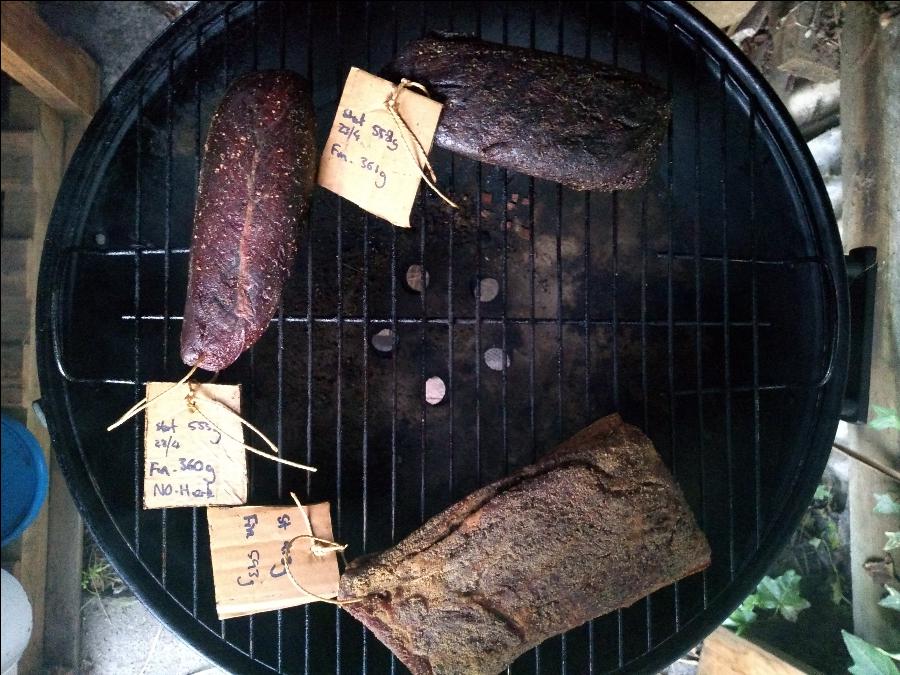
When it comes to fillets or whole fish hanging is generally the preferred way. You can get away as well with racks – it’s definitely a lot cleaner and tidier with fish to hang. Less contact on the meat is ideal too.
One trick I have used for years, is if there is some racking you can just end up tying some twine or jute to a tough bit of the meat and poking the string through the rack sticking a piece of wood or chopstick through.
Here’s a pic.
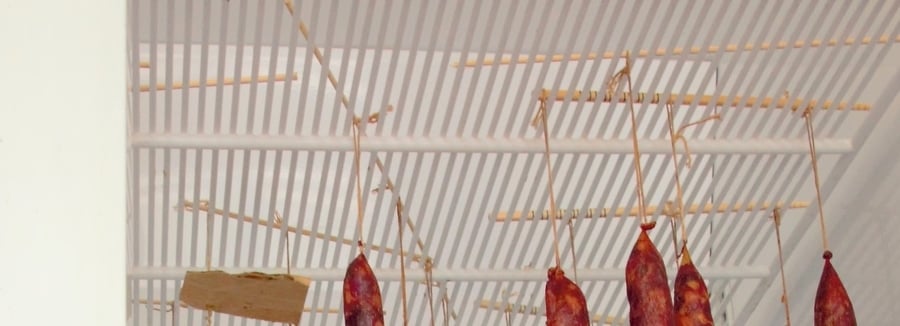
Of course, adjustable racking or hanging is ideal but just depends on the setup and what you try to achieve thought I would just mention this for something to think of.
Big or Small DIY Cold Smoker
- Fridges
- Kettle BBQs
- Filing Cabinets
- Terracotta Pots
- 40 Gallon Drum
- Cardboard Boxes
- Wine Barrels
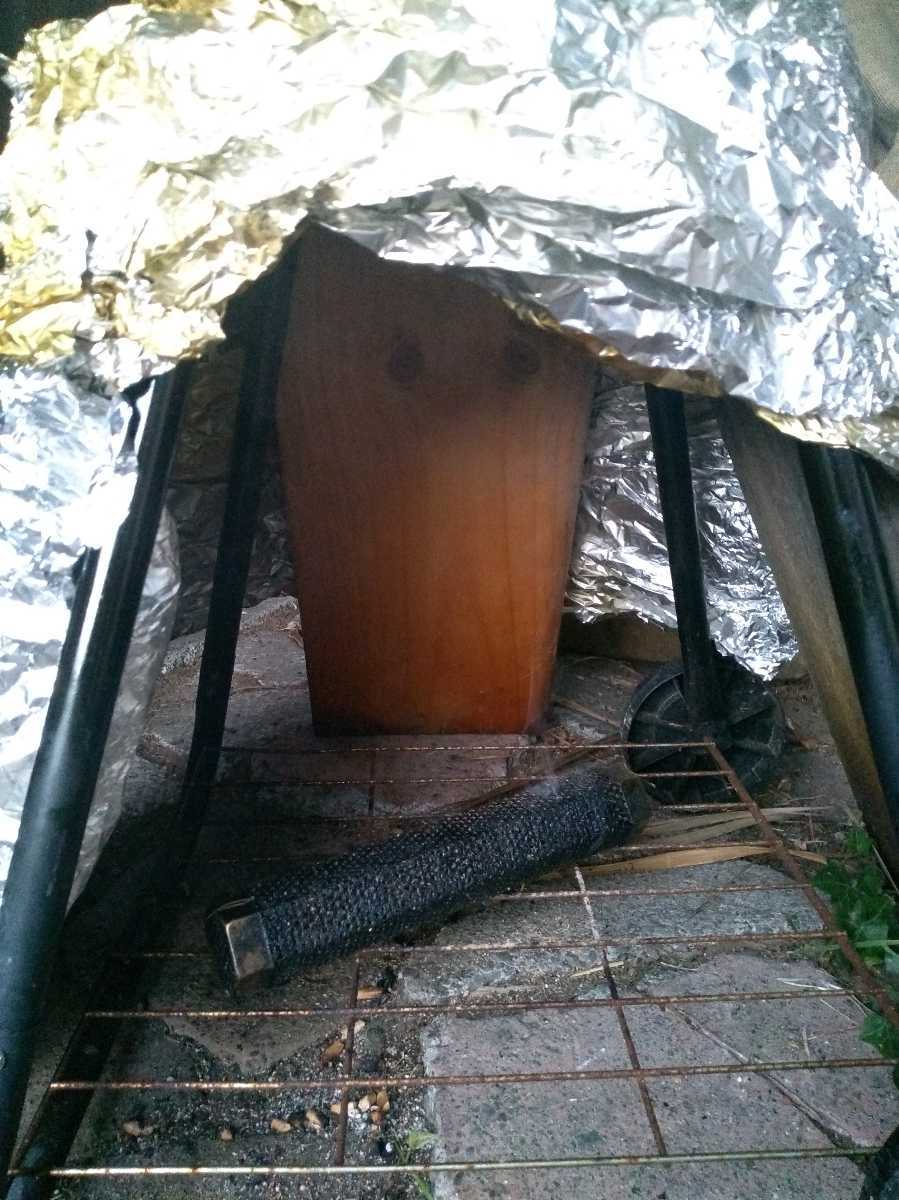
The first DIY Cold Smoker I saw was at the back of a Dutch butcher when I was a student. It was basically a big sturdy heavy steel double-doored container that was about 12 feet high.
He got untreated leftover dark hardwoods from a local furniture maker.
It was a kind of twirly dry offcut sawdust.
He let it burn briefly with a lighter blew it out and left it. Sometimes he left the door a little bit open so it had airflow. Simple, but that was it.
And of course, he made delicious smoked goods, using a blend of woods but predominantly mahogany, which was interesting.
So the point I’m trying to make is that can be incredibly simple, I’ll go over the main ones below that I have seen more often.
But whether you put a pellet tube under a kettle barbecue or have a ducting pipe into a filing cabinet. These are all simple DIY cold-smoked ideas to get your brain thinking!
Here is a video I made about various setups and some tips.
1. Pile of Sawdust or Wood
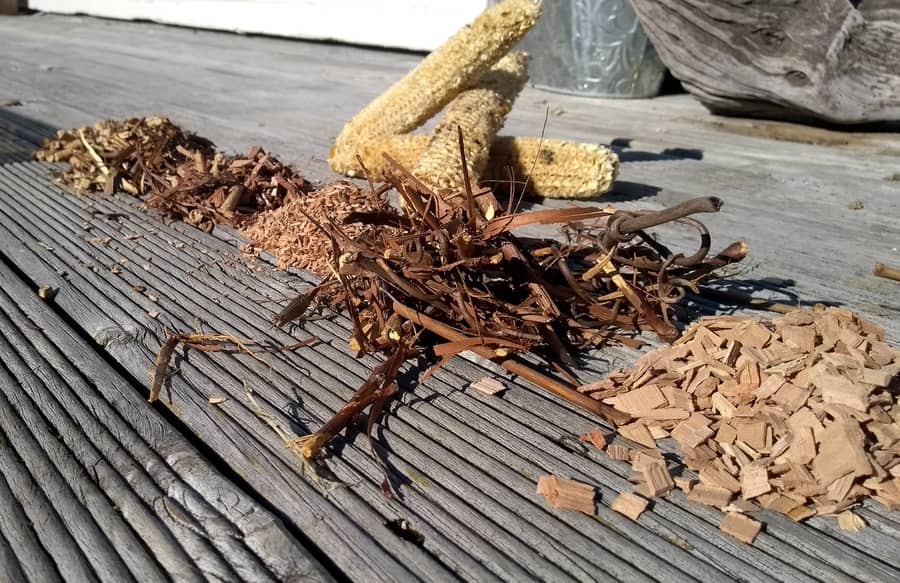
As long as you’ve got dry, good-smoking hardwood and airflow, you’re good to go. Once you get a smoldering fire of sawdust, wood chips, and pellets going, you’re cold smoking.
The pellet tube I’ll discuss below runs on this principle and is simple, cost-effective, and adaptable to many applications.
Sometimes it takes a little bit of experimentation to find out what works.
But my key advice is that you start off with less smoke rather than more. The worst thing is you spend all that time curing something or preparing it, and then you over smoke it and it’s bitter.
TIP—Sticking whatever you’re cold smoking in the fridge for at least a few hours or overnight will change the flavor completely, and you’ll get a more intense smokiness than when you just pull it out of the cold smoker and try it.
2. Pellet Tube Cold Smoker
I think a 12-inch pellet tube is one of my favorite ways of cold smoking
It’s what I’ll be using in a cardboard box today.
But I can use it for larger stainless steel commercial cold smokers. Or I have even used it on my 5 burner gas grill, putting it down below to cold-smoke some Hungarian salami like this!
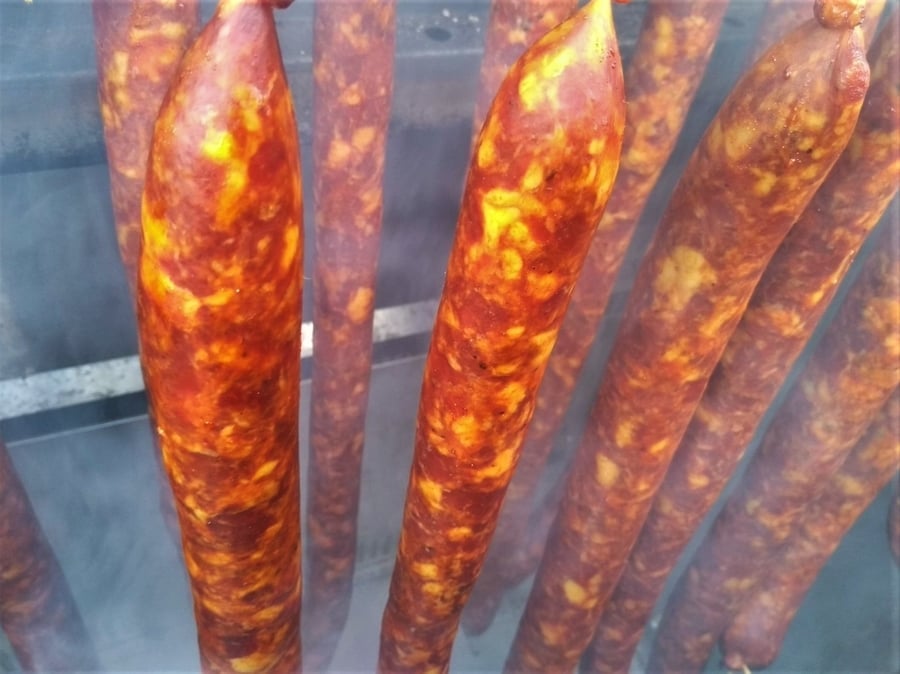
It takes a couple of minutes with a decent butane torch or crème brûlée torch, don’t even bother trying to use a normal lighter. Once a flame gets about 5 or 6 inches high. Blow it out and place it to the side and you will have 3 to 5 hours of consistent cold smoking.
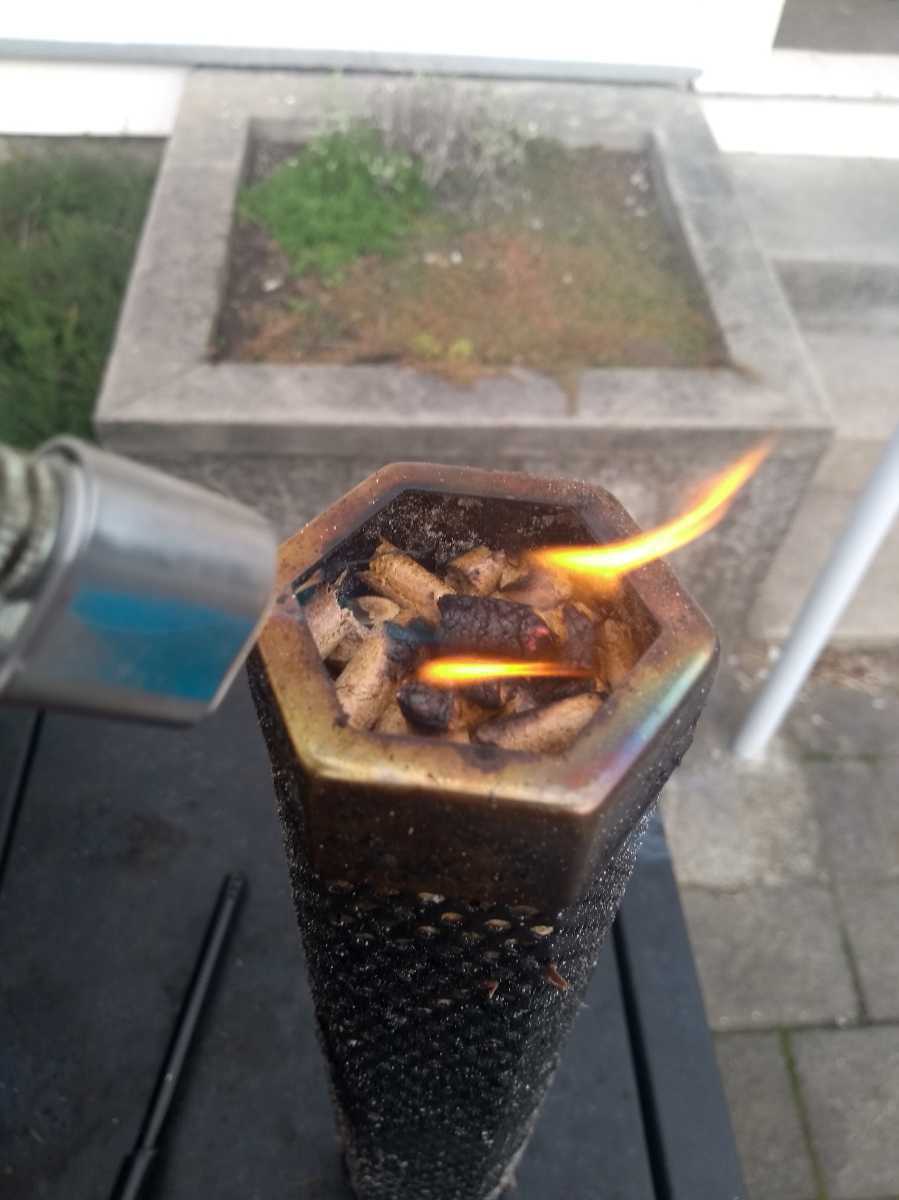
As long as you have good dry wood pellets. Sometimes I do a mix of a little bit of chipped grapevine wood or other aspects as long as it’s still mostly pellet wood it seems to burn very nicely. Room to explore options here!
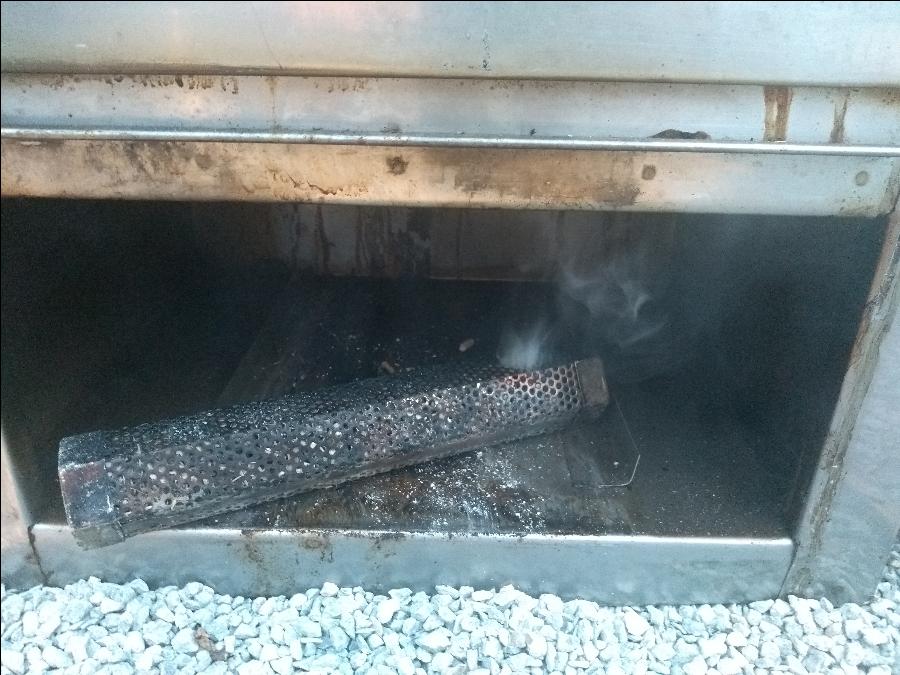
Here are some tips I talk about with a pellet tube smoker:
3. Maze Cold Smoker
Similar but a little bit different than the pellet tube smoker, the maze smoker sometimes has a finer mesh and can work very well for esaw dust or pellets.
Some designs, like this maze smoker, only need a tea candle to get going which means you don’t need the butane torch which is a bonus as well I guess (you will need to use sawdust though).
If you are really on a budget or know a motorcycle mechanic, I did initially try and get a perforated exhaust baffle, but the only ones I could find were from muffler shops, and the car-type source baffles were too heavy gauge metal and probably needed more perforated holes.
The $10-20 bucks buying a pellet tube seems to be a much easier option. Use a few different types of wood. It’s simple, reliable and can be stuck into any chamber – this is a decent 12″ one I use.
You need a basic lighter like this.
4. Grill Retrofit Cold Smoker
Using a smoke generator that has an air pump control, it can be easily retrofitted to a gas grill.
Smoke Generators (review of one of my favorites) can be fitted to a whole bunch of options, having that extra control over airflow, does make a bit of difference to outcomes.
If you want to read a full page on smoke generators, I wrote about them here.
5. Smokehouse- Classic Smoke Chamber & Meat Chamber
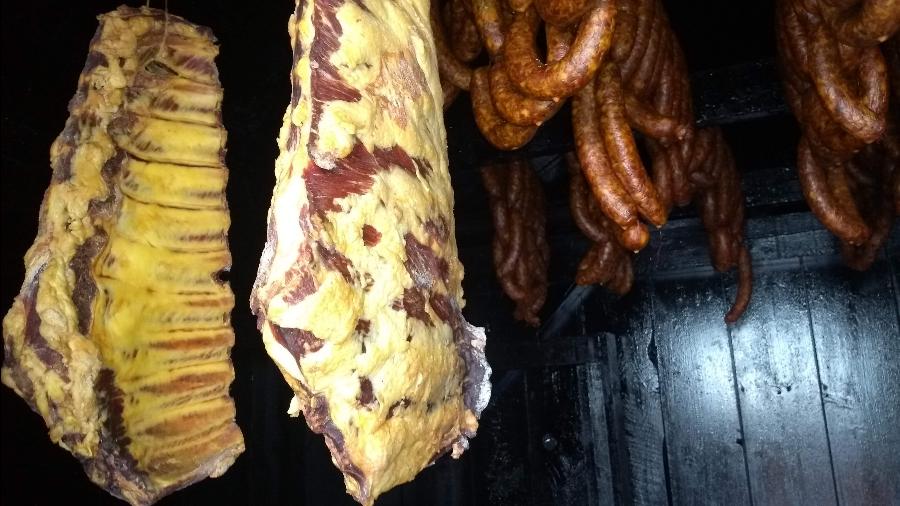
Brick, Wood, Concrete – all sorted of options.
I have seen so many variations of smokehouses the principles are always the same, with enough space inside a large chamber, if it’s smoldering and smoking and not heating up the chamber, you are effectively cold smoking.
Or you have a separate burning smoking chamber that is ducted or piped to a food or meat chamber.
The famous fish smokehouse in my area told me it took 5-6 years to get the wood inside their smokehouse covered and flavored with the vapor smoke resin. Then, they were happy with the smoked goods.
These long and slow foods and drinks, good things take time.
Dry curing meat, such as Parma Ham, with a minimum of 12 months to 5 years, can produce exceptional results.
12 or 25-year-old Modena traditional balsamic vinegar
Or a well-aged malt whiskey/whisky.
And even cold smoking for flavor and preservation.
Here is a link to AgCenter for smokehouse designs of various materials – a gov site with smokehouse plans
6. Retro Fit Wood or Charcoal Smoke
So it’s a little bit rough and redneck, but I did back in the day wrapup tinfoil on the legs of the kettle barbecue the real cheeky.
And then used a pellet tube below this say the smoke just went through the air intake at the bottom of the kettle barbecue.
Basically, you use the existing smoker as a chamber, and then all you need is a maze smoker, pellet tube, or smoke generator.
7. Pellet Grill Retrofit Cold Smoker
If you’re using a pellet grill when it’s not turned on it doesn’t have any issues because you probably aren’t having any pressurizing going on which can be a factor when retrofitting a pellet grill.
Like the above charcoal smokers, you’re just using the existing smoke as the chamber.
You can drill a hole and do a cold smoke generator through the back of it.
Final DIY Cold Smoker Thoughts
If you want to make life simple when it comes to making a DIY cold smoker.
If you get a pellet tube smoker you have many options all you need is a chamber whether it’s a cardboard box or a beautiful brick smokehouse.
Just remember that keeping the heat low is the key (10-20°C/50-68°F). The more solid the structure, the more insulated you may be.
Or the smaller the area the quicker it can heat up. Keep this in mind when you’re building those plans up.
Well, I had better get to my cowboy cardboard bacon cold smoking setup!
Oh, and one last tip: don’t cold-smoke in the sun unless you are in a super cold climate!

Tom Mueller
For decades, immersed in studying, working, learning, and teaching the craft of meat curing, sharing the passion and showcasing the world of charcuterie and smoked meat. Read More
